Fei Ding
Alibaba Group
USO: Unified Style and Subject-Driven Generation via Disentangled and Reward Learning
Aug 26, 2025Abstract:Existing literature typically treats style-driven and subject-driven generation as two disjoint tasks: the former prioritizes stylistic similarity, whereas the latter insists on subject consistency, resulting in an apparent antagonism. We argue that both objectives can be unified under a single framework because they ultimately concern the disentanglement and re-composition of content and style, a long-standing theme in style-driven research. To this end, we present USO, a Unified Style-Subject Optimized customization model. First, we construct a large-scale triplet dataset consisting of content images, style images, and their corresponding stylized content images. Second, we introduce a disentangled learning scheme that simultaneously aligns style features and disentangles content from style through two complementary objectives, style-alignment training and content-style disentanglement training. Third, we incorporate a style reward-learning paradigm denoted as SRL to further enhance the model's performance. Finally, we release USO-Bench, the first benchmark that jointly evaluates style similarity and subject fidelity across multiple metrics. Extensive experiments demonstrate that USO achieves state-of-the-art performance among open-source models along both dimensions of subject consistency and style similarity. Code and model: https://github.com/bytedance/USO
Improved Supervised Fine-Tuning for Large Language Models to Mitigate Catastrophic Forgetting
Jun 11, 2025Abstract:Supervised Fine-Tuning (SFT), while enhancing large language models(LLMs)' instruction-following capabilities and domain-specific task adaptability, often diminishes their general capabilities. Moreover, due to the inaccessibility of original pre-training data, catastrophic forgetting tends to be exacerbated when third-party practitioners implement SFT on open-sourced models. To address this challenge, we propose a novel, more cost-effective SFT method which could effectively reduce the risk of catastrophic forgetting without access to original SFT data. Our approach begins by reconstructing the likely SFT instruction distribution of the base model, followed by a multi-model screening process to select optimal data, which is then mixed with new data for SFT. Experimental results demonstrate that our method preserves generalization capabilities in general domains while improving task-specific performance.
Multi-Layer GRPO: Enhancing Reasoning and Self-Correction in Large Language Models
Jun 05, 2025Abstract:The Group Relative Policy Optimization (GRPO) algorithm has demonstrated considerable success in enhancing the reasoning capabilities of large language models (LLMs), as evidenced by DeepSeek-R1. However, the absence of intermediate supervision in GRPO frequently leads to inefficient exploration dynamics. A single error in a complex reasoning chain can invalidate the entire solution, resulting in abrupt reward vanishing and compromising training stability.To address these challenges, we propose MGRPO (Multi-layer GRPO). MGRPO operates in two layers: the first layer employs standard GRPO to generate an initial response. This response, along with the original query, is then fed into a second-layer GRPO process. This second layer is specifically trained to identify and correct errors in the initial response, effectively creating a self-correction loop. This mechanism provides implicit process-level supervision by rewarding successful error correction, without requiring an explicit, densely-annotated reward model. Experimental results on several mathematical reasoning benchmarks demonstrate that MGRPO significantly outperforms standard GRPO, achieving superior performance by fostering both reasoning and self-correction abilities.
Socially-Aware Autonomous Driving: Inferring Yielding Intentions for Safer Interactions
Apr 28, 2025



Abstract:Since the emergence of autonomous driving technology, it has advanced rapidly over the past decade. It is becoming increasingly likely that autonomous vehicles (AVs) would soon coexist with human-driven vehicles (HVs) on the roads. Currently, safety and reliable decision-making remain significant challenges, particularly when AVs are navigating lane changes and interacting with surrounding HVs. Therefore, precise estimation of the intentions of surrounding HVs can assist AVs in making more reliable and safe lane change decision-making. This involves not only understanding their current behaviors but also predicting their future motions without any direct communication. However, distinguishing between the passing and yielding intentions of surrounding HVs still remains ambiguous. To address the challenge, we propose a social intention estimation algorithm rooted in Directed Acyclic Graph (DAG), coupled with a decision-making framework employing Deep Reinforcement Learning (DRL) algorithms. To evaluate the method's performance, the proposed framework can be tested and applied in a lane-changing scenario within a simulated environment. Furthermore, the experiment results demonstrate how our approach enhances the ability of AVs to navigate lane changes safely and efficiently on roads.
DreamO: A Unified Framework for Image Customization
Apr 23, 2025Abstract:Recently, extensive research on image customization (e.g., identity, subject, style, background, etc.) demonstrates strong customization capabilities in large-scale generative models. However, most approaches are designed for specific tasks, restricting their generalizability to combine different types of condition. Developing a unified framework for image customization remains an open challenge. In this paper, we present DreamO, an image customization framework designed to support a wide range of tasks while facilitating seamless integration of multiple conditions. Specifically, DreamO utilizes a diffusion transformer (DiT) framework to uniformly process input of different types. During training, we construct a large-scale training dataset that includes various customization tasks, and we introduce a feature routing constraint to facilitate the precise querying of relevant information from reference images. Additionally, we design a placeholder strategy that associates specific placeholders with conditions at particular positions, enabling control over the placement of conditions in the generated results. Moreover, we employ a progressive training strategy consisting of three stages: an initial stage focused on simple tasks with limited data to establish baseline consistency, a full-scale training stage to comprehensively enhance the customization capabilities, and a final quality alignment stage to correct quality biases introduced by low-quality data. Extensive experiments demonstrate that the proposed DreamO can effectively perform various image customization tasks with high quality and flexibly integrate different types of control conditions.
Less-to-More Generalization: Unlocking More Controllability by In-Context Generation
Apr 02, 2025Abstract:Although subject-driven generation has been extensively explored in image generation due to its wide applications, it still has challenges in data scalability and subject expansibility. For the first challenge, moving from curating single-subject datasets to multiple-subject ones and scaling them is particularly difficult. For the second, most recent methods center on single-subject generation, making it hard to apply when dealing with multi-subject scenarios. In this study, we propose a highly-consistent data synthesis pipeline to tackle this challenge. This pipeline harnesses the intrinsic in-context generation capabilities of diffusion transformers and generates high-consistency multi-subject paired data. Additionally, we introduce UNO, which consists of progressive cross-modal alignment and universal rotary position embedding. It is a multi-image conditioned subject-to-image model iteratively trained from a text-to-image model. Extensive experiments show that our method can achieve high consistency while ensuring controllability in both single-subject and multi-subject driven generation.
VMix: Improving Text-to-Image Diffusion Model with Cross-Attention Mixing Control
Dec 30, 2024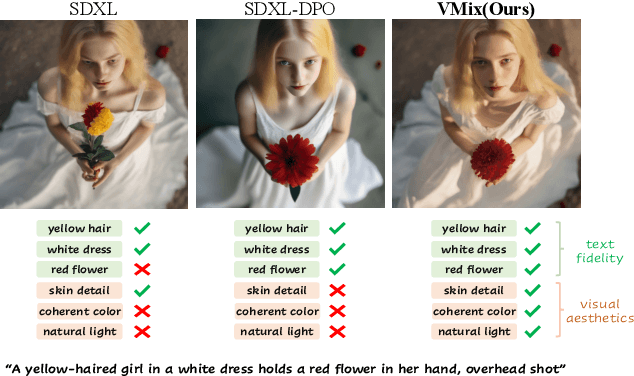
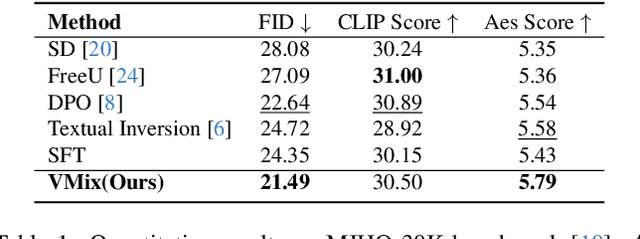

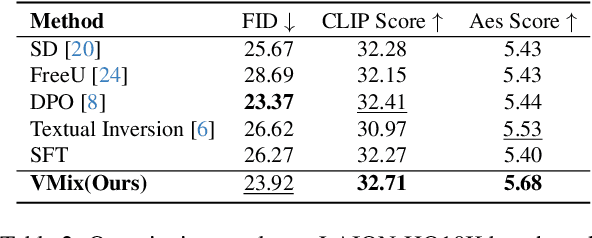
Abstract:While diffusion models show extraordinary talents in text-to-image generation, they may still fail to generate highly aesthetic images. More specifically, there is still a gap between the generated images and the real-world aesthetic images in finer-grained dimensions including color, lighting, composition, etc. In this paper, we propose Cross-Attention Value Mixing Control (VMix) Adapter, a plug-and-play aesthetics adapter, to upgrade the quality of generated images while maintaining generality across visual concepts by (1) disentangling the input text prompt into the content description and aesthetic description by the initialization of aesthetic embedding, and (2) integrating aesthetic conditions into the denoising process through value-mixed cross-attention, with the network connected by zero-initialized linear layers. Our key insight is to enhance the aesthetic presentation of existing diffusion models by designing a superior condition control method, all while preserving the image-text alignment. Through our meticulous design, VMix is flexible enough to be applied to community models for better visual performance without retraining. To validate the effectiveness of our method, we conducted extensive experiments, showing that VMix outperforms other state-of-the-art methods and is compatible with other community modules (e.g., LoRA, ControlNet, and IPAdapter) for image generation. The project page is https://vmix-diffusion.github.io/VMix/.
RealCustom++: Representing Images as Real-Word for Real-Time Customization
Aug 19, 2024
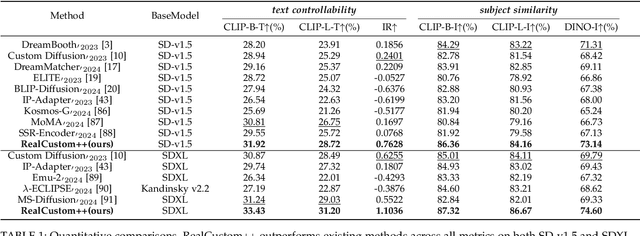
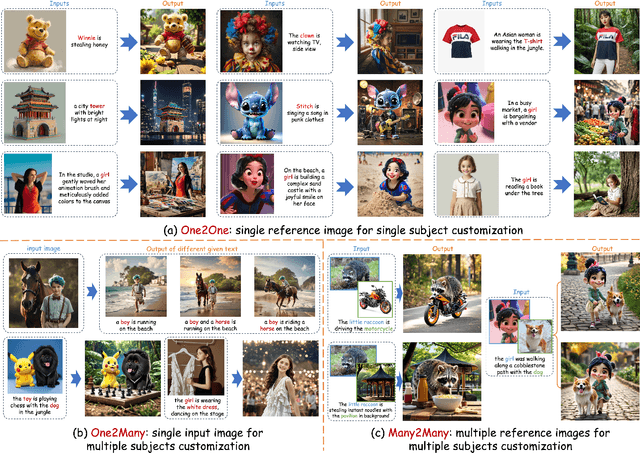

Abstract:Text-to-image customization, which takes given texts and images depicting given subjects as inputs, aims to synthesize new images that align with both text semantics and subject appearance. This task provides precise control over details that text alone cannot capture and is fundamental for various real-world applications, garnering significant interest from academia and industry. Existing works follow the pseudo-word paradigm, which involves representing given subjects as pseudo-words and combining them with given texts to collectively guide the generation. However, the inherent conflict and entanglement between the pseudo-words and texts result in a dual-optimum paradox, where subject similarity and text controllability cannot be optimal simultaneously. We propose a novel real-words paradigm termed RealCustom++ that instead represents subjects as non-conflict real words, thereby disentangling subject similarity from text controllability and allowing both to be optimized simultaneously. Specifically, RealCustom++ introduces a novel "train-inference" decoupled framework: (1) During training, RealCustom++ learns the alignment between vision conditions and all real words in the text, ensuring high subject-similarity generation in open domains. This is achieved by the cross-layer cross-scale projector to robustly and finely extract subject features, and a curriculum training recipe that adapts the generated subject to diverse poses and sizes. (2) During inference, leveraging the learned general alignment, an adaptive mask guidance is proposed to only customize the generation of the specific target real word, keeping other subject-irrelevant regions uncontaminated to ensure high text-controllability in real-time.
MSSTNet: A Multi-Scale Spatio-Temporal CNN-Transformer Network for Dynamic Facial Expression Recognition
Apr 12, 2024



Abstract:Unlike typical video action recognition, Dynamic Facial Expression Recognition (DFER) does not involve distinct moving targets but relies on localized changes in facial muscles. Addressing this distinctive attribute, we propose a Multi-Scale Spatio-temporal CNN-Transformer network (MSSTNet). Our approach takes spatial features of different scales extracted by CNN and feeds them into a Multi-scale Embedding Layer (MELayer). The MELayer extracts multi-scale spatial information and encodes these features before sending them into a Temporal Transformer (T-Former). The T-Former simultaneously extracts temporal information while continually integrating multi-scale spatial information. This process culminates in the generation of multi-scale spatio-temporal features that are utilized for the final classification. Our method achieves state-of-the-art results on two in-the-wild datasets. Furthermore, a series of ablation experiments and visualizations provide further validation of our approach's proficiency in leveraging spatio-temporal information within DFER.
* Accepted to 2024 IEEE International Conference on Acoustics, Speech, and Signal Processing (ICASSP 2024)
DreamTuner: Single Image is Enough for Subject-Driven Generation
Dec 21, 2023Abstract:Diffusion-based models have demonstrated impressive capabilities for text-to-image generation and are expected for personalized applications of subject-driven generation, which require the generation of customized concepts with one or a few reference images. However, existing methods based on fine-tuning fail to balance the trade-off between subject learning and the maintenance of the generation capabilities of pretrained models. Moreover, other methods that utilize additional image encoders tend to lose important details of the subject due to encoding compression. To address these challenges, we propose DreamTurner, a novel method that injects reference information from coarse to fine to achieve subject-driven image generation more effectively. DreamTurner introduces a subject-encoder for coarse subject identity preservation, where the compressed general subject features are introduced through an attention layer before visual-text cross-attention. We then modify the self-attention layers within pretrained text-to-image models to self-subject-attention layers to refine the details of the target subject. The generated image queries detailed features from both the reference image and itself in self-subject-attention. It is worth emphasizing that self-subject-attention is an effective, elegant, and training-free method for maintaining the detailed features of customized subjects and can serve as a plug-and-play solution during inference. Finally, with additional subject-driven fine-tuning, DreamTurner achieves remarkable performance in subject-driven image generation, which can be controlled by a text or other conditions such as pose. For further details, please visit the project page at https://dreamtuner-diffusion.github.io/.
 Add to Chrome
Add to Chrome Add to Firefox
Add to Firefox Add to Edge
Add to Edge